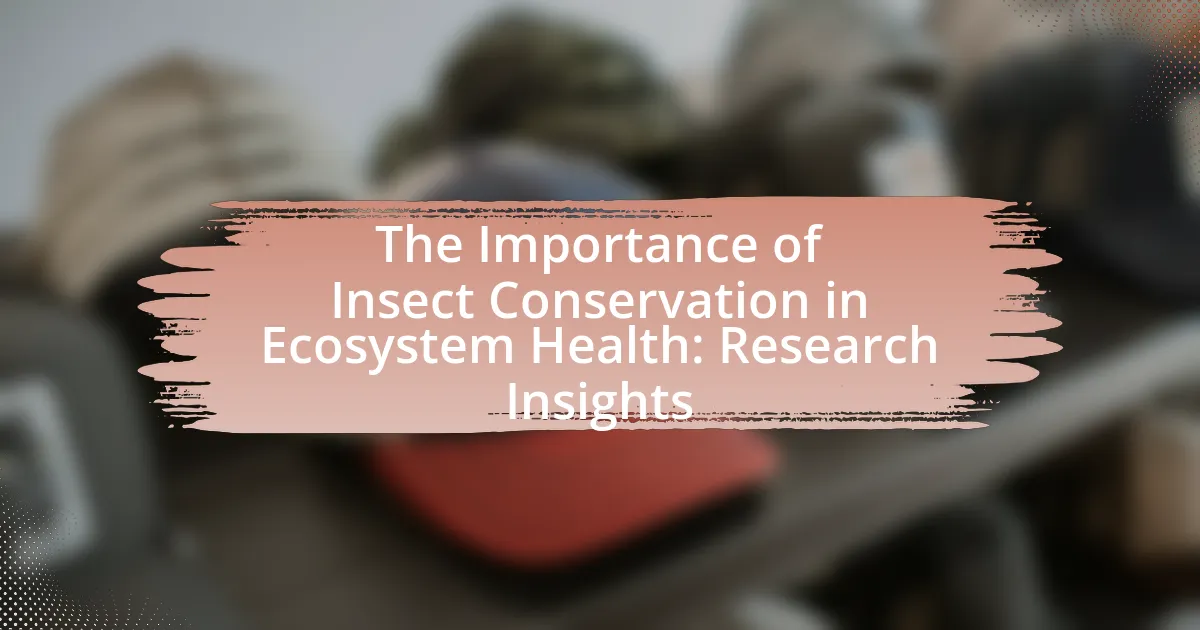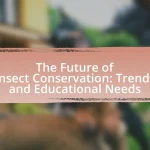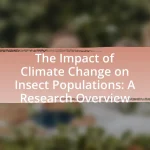The article focuses on the critical role of insect conservation in maintaining ecosystem health, emphasizing the essential functions insects perform, such as pollination, nutrient cycling, and serving as a food source for other organisms. It highlights the alarming decline in insect populations due to threats like habitat loss, pesticide use, and climate change, which disrupts ecological balance and threatens biodiversity. Key research findings underscore the interconnectedness of insect health with overall ecosystem stability, food security, and biodiversity, advocating for conservation strategies that include habitat restoration and community engagement. The article also discusses practical steps individuals can take to support insect populations, such as promoting native plant gardening and participating in citizen science initiatives.
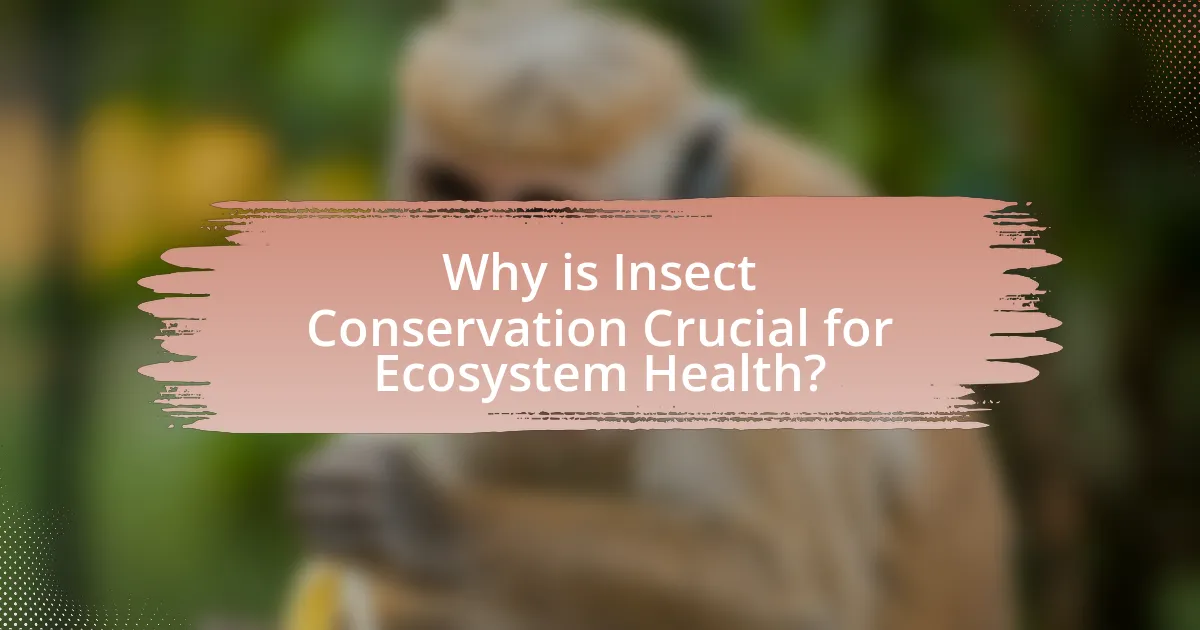
Why is Insect Conservation Crucial for Ecosystem Health?
Insect conservation is crucial for ecosystem health because insects play essential roles in pollination, nutrient cycling, and food web dynamics. For instance, approximately 75% of flowering plants depend on insect pollinators, which directly supports agricultural productivity and biodiversity. Additionally, insects contribute to soil health by decomposing organic matter, thus enhancing nutrient availability for plants. Research indicates that declines in insect populations can lead to significant disruptions in these ecological functions, resulting in reduced plant diversity and compromised ecosystem resilience. Therefore, protecting insect populations is vital for maintaining the overall health and stability of ecosystems.
What roles do insects play in maintaining ecosystem balance?
Insects play crucial roles in maintaining ecosystem balance through pollination, decomposition, and serving as a food source for other organisms. Pollinators, such as bees and butterflies, facilitate the reproduction of flowering plants, which is essential for food production and habitat stability. Decomposers, including beetles and ants, break down organic matter, recycling nutrients back into the soil, which supports plant growth and soil health. Additionally, insects are integral to food webs, providing sustenance for birds, mammals, and other wildlife, thereby supporting biodiversity. Research indicates that approximately 75% of the world’s flowering plants rely on animal pollinators, highlighting the significance of insects in ecosystem functionality.
How do insects contribute to pollination and plant reproduction?
Insects contribute to pollination and plant reproduction by transferring pollen from the male parts of flowers to the female parts, facilitating fertilization. This process is essential for the production of seeds and fruits in many flowering plants. For instance, approximately 75% of the world’s flowering plants depend on animal pollinators, primarily insects, to reproduce effectively. Studies have shown that insect pollination increases crop yields significantly; for example, crops like apples and almonds can see yield increases of up to 90% when pollinated by insects. Thus, the role of insects in pollination is critical for maintaining biodiversity and ensuring food security.
What is the significance of insects in nutrient cycling?
Insects play a crucial role in nutrient cycling by facilitating the decomposition of organic matter and recycling nutrients back into the ecosystem. They contribute to this process through activities such as breaking down dead plant and animal material, which enhances soil fertility and promotes plant growth. For instance, studies have shown that detritivorous insects, like earthworms and beetles, significantly accelerate the decomposition rate, leading to increased nutrient availability in the soil. This process is vital for maintaining ecosystem health, as it supports plant productivity and sustains food webs.
How does the decline of insect populations affect ecosystems?
The decline of insect populations significantly disrupts ecosystems by impairing pollination, nutrient cycling, and food web dynamics. Insects are crucial pollinators for approximately 75% of flowering plants, including many crops; their decline can lead to reduced plant reproduction and biodiversity loss. Furthermore, insects contribute to nutrient cycling by decomposing organic matter, which enriches soil health; a decrease in their populations can result in slower decomposition rates and nutrient depletion. Additionally, insects serve as a primary food source for many animals, including birds and mammals; their decline can lead to decreased populations of these predators, disrupting the entire food web. Studies indicate that regions experiencing significant insect population declines also show corresponding declines in bird populations and plant diversity, highlighting the interconnectedness of these ecological components.
What are the consequences of reduced pollinator populations?
Reduced pollinator populations lead to significant declines in crop yields and biodiversity. Pollinators, such as bees and butterflies, are essential for the fertilization of many flowering plants, including over 75% of the world’s food crops. A study published in the journal “Nature” found that a 50% reduction in pollinator populations could result in a 20-30% decrease in global crop production. This decline not only threatens food security but also disrupts ecosystems, as many plants rely on pollinators for reproduction. Consequently, reduced pollinator populations can lead to diminished plant diversity, affecting entire food webs and ecosystem stability.
How does insect loss impact food webs and biodiversity?
Insect loss significantly disrupts food webs and reduces biodiversity. Insects serve as crucial food sources for many species, including birds, mammals, and amphibians; their decline leads to decreased populations of these predators. For instance, studies indicate that a 50% decline in insect biomass can result in a corresponding decline in bird populations by up to 30% due to food scarcity. Furthermore, insects play essential roles in pollination and nutrient cycling, which are vital for plant reproduction and soil health. The loss of insect diversity can lead to the collapse of ecosystems, as seen in regions where pollinator populations have dwindled, resulting in reduced crop yields and altered plant communities. Thus, the decline of insects directly threatens the stability and resilience of ecosystems.
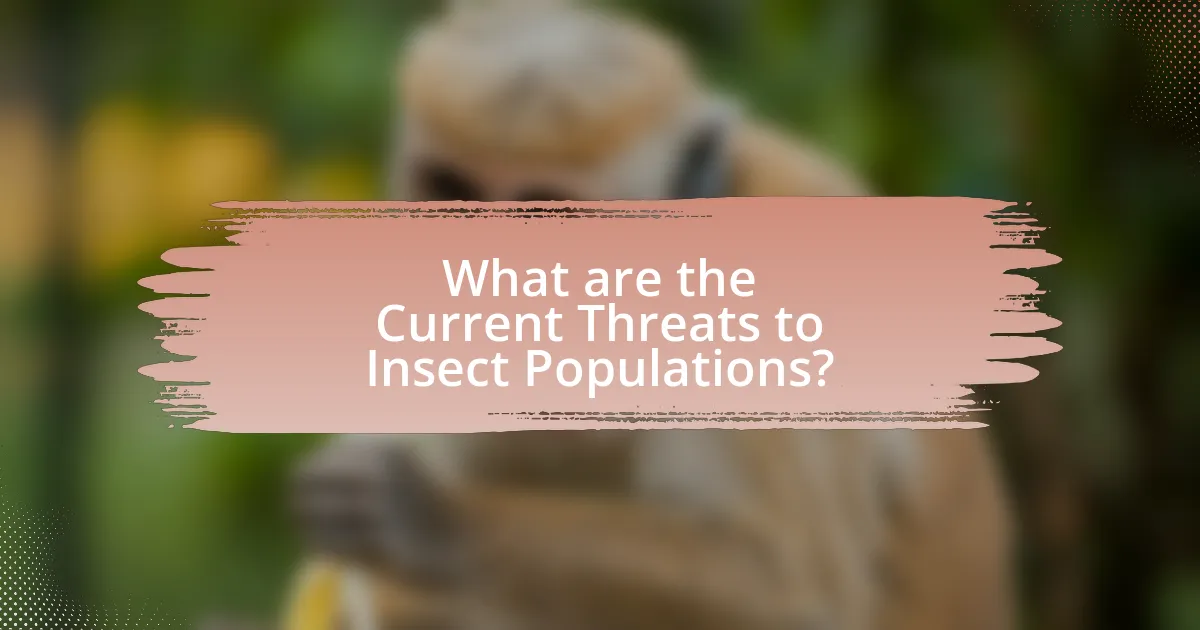
What are the Current Threats to Insect Populations?
Current threats to insect populations include habitat loss, pesticide use, climate change, and invasive species. Habitat loss, driven by urbanization and agricultural expansion, reduces the available environments for insects to thrive. Pesticide use, particularly neonicotinoids, has been linked to declines in pollinator populations, with studies indicating that these chemicals can impair reproduction and navigation. Climate change alters ecosystems and disrupts life cycles, leading to mismatches in food availability and habitat suitability. Invasive species can outcompete native insects for resources, further threatening their survival. Collectively, these factors contribute to a significant decline in insect biodiversity, with research indicating that nearly 40% of insect species are experiencing population decreases globally.
How do habitat loss and degradation affect insects?
Habitat loss and degradation significantly reduce insect populations and biodiversity. Insects rely on specific habitats for food, shelter, and reproduction; when these environments are altered or destroyed, their survival is jeopardized. For instance, studies indicate that agricultural expansion and urban development have led to a decline in insect species by up to 75% in some regions, as reported in the “Insect Declines in the Anthropocene” study published in Biological Conservation. This loss of habitat disrupts ecological interactions, such as pollination and nutrient cycling, further destabilizing ecosystems.
What specific human activities contribute to habitat destruction?
Deforestation is a specific human activity that contributes significantly to habitat destruction. This occurs when forests are cleared for agriculture, logging, or urban development, leading to the loss of biodiversity and disruption of ecosystems. According to the Food and Agriculture Organization, approximately 10 million hectares of forest are lost each year, which directly impacts insect populations and their roles in ecosystem health. Additionally, urbanization leads to habitat fragmentation, isolating species and reducing their ability to thrive. Overexploitation of resources, such as mining and fishing, further exacerbates habitat loss, as these activities degrade natural environments and diminish the habitats necessary for various insect species.
How does urbanization impact local insect species?
Urbanization negatively impacts local insect species by altering their habitats and reducing biodiversity. The transformation of natural landscapes into urban environments leads to habitat fragmentation, which disrupts the life cycles and migration patterns of many insect species. For instance, studies have shown that urban areas often experience a decline in pollinator populations, such as bees, due to the loss of flowering plants and nesting sites. Research published in the journal “Ecological Applications” indicates that urbanization can decrease insect diversity by up to 50% in some regions, highlighting the significant threat it poses to local ecosystems.
What role do pesticides play in insect population decline?
Pesticides significantly contribute to insect population decline by causing direct mortality and disrupting reproductive processes. Studies indicate that neonicotinoids, a class of widely used pesticides, have been linked to reduced survival rates in pollinators such as bees, with research showing that exposure can lead to a 50% decline in bee populations in affected areas. Additionally, pesticides can harm non-target insect species, leading to a decrease in biodiversity and altering ecosystem dynamics. The cumulative effects of pesticide use, including habitat degradation and the development of pesticide resistance, further exacerbate the decline of insect populations, threatening ecosystem health and stability.
How do different types of pesticides affect insect health?
Different types of pesticides significantly impact insect health by causing physiological and behavioral changes. Insecticides, particularly those targeting the nervous system, can lead to paralysis and death, while herbicides may indirectly affect insects by reducing their food sources. For example, neonicotinoids, a class of insecticides, have been shown to impair foraging behavior and reproductive success in bees, which are crucial pollinators. Research published in “Nature” by Goulson et al. (2018) indicates that exposure to these chemicals can reduce bee populations by up to 50%. Additionally, fungicides can disrupt the microbiome of insects, affecting their immunity and overall health. Thus, the type of pesticide used plays a critical role in determining the extent of its effects on insect populations and, consequently, ecosystem health.
What alternatives to pesticides can support insect conservation?
Alternatives to pesticides that can support insect conservation include integrated pest management (IPM), biological control, and the use of organic farming practices. Integrated pest management combines various control methods, such as cultural practices, mechanical controls, and biological agents, to minimize pest populations while reducing reliance on chemical pesticides. Biological control involves the use of natural predators or parasites to manage pest populations, which has been shown to effectively reduce pest numbers without harming beneficial insects. Organic farming practices, which avoid synthetic pesticides and fertilizers, promote biodiversity and enhance habitat for beneficial insects, thereby supporting overall insect conservation. Research indicates that these methods can lead to healthier ecosystems and improved insect populations, as evidenced by studies demonstrating increased biodiversity in organic farming systems compared to conventional methods.
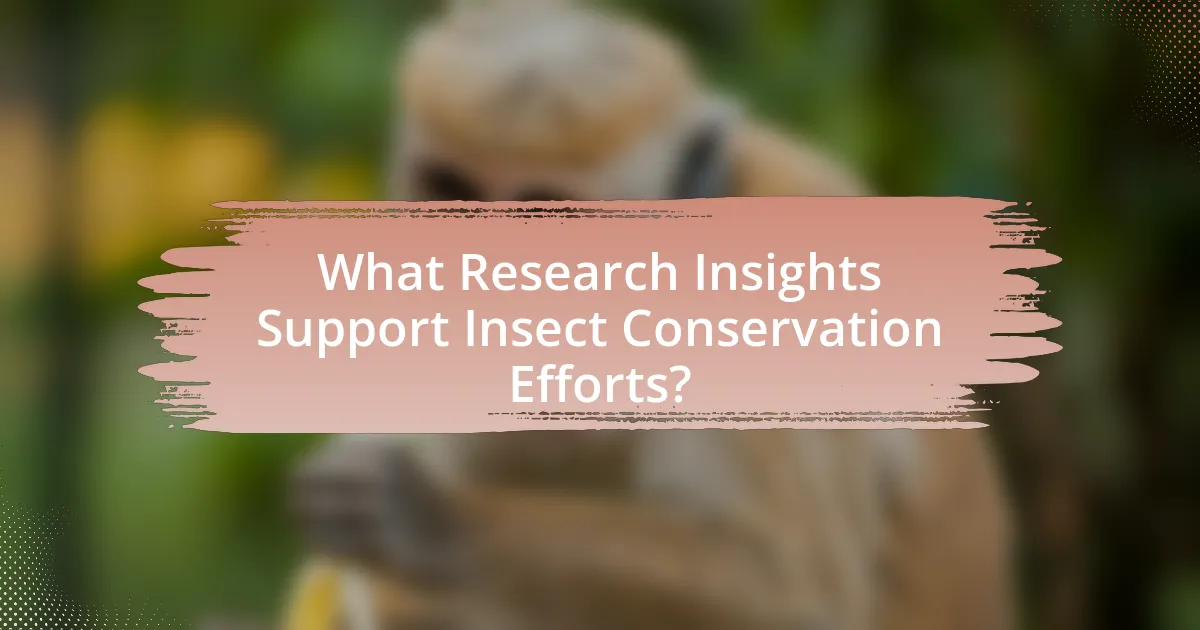
What Research Insights Support Insect Conservation Efforts?
Research insights supporting insect conservation efforts highlight the critical role insects play in ecosystem services, such as pollination, nutrient cycling, and pest control. Studies indicate that approximately 75% of global food crops depend on insect pollination, underscoring their importance in agriculture and food security. Additionally, research published in the journal “Biological Conservation” by Hallmann et al. (2017) reveals a dramatic decline in insect biomass, with a loss of nearly 75% over 27 years in certain regions, emphasizing the urgent need for conservation measures. Furthermore, the decline of insect populations can disrupt food webs and lead to cascading effects on biodiversity, as documented in various ecological studies. These insights collectively underscore the necessity of implementing conservation strategies to protect insect populations and, by extension, maintain ecosystem health.
What are the key findings from recent studies on insect populations?
Recent studies on insect populations indicate a significant decline in biodiversity, with global insect biomass decreasing by approximately 2.5% per year. This decline is attributed to habitat loss, pesticide use, climate change, and pollution. For instance, a comprehensive review published in the journal Biological Conservation highlighted that nearly 40% of insect species are threatened with extinction, emphasizing the urgent need for conservation efforts. Additionally, research from the University of Sussex found that agricultural practices are a major driver of this decline, as they disrupt habitats and reduce food sources for insects. These findings underscore the critical role insects play in ecosystem health, including pollination and nutrient cycling, and the necessity for immediate action to protect these vital species.
How do these studies highlight the importance of insect diversity?
Studies highlight the importance of insect diversity by demonstrating its critical role in ecosystem functioning and resilience. Research indicates that diverse insect populations contribute to pollination, nutrient cycling, and pest control, which are essential for maintaining healthy ecosystems. For instance, a study published in the journal “Nature” by Cardinale et al. (2012) found that ecosystems with higher insect diversity exhibited greater productivity and stability, underscoring the link between biodiversity and ecosystem services. Additionally, the decline of insect diversity has been correlated with negative impacts on food webs and ecosystem health, as shown in various ecological assessments. These findings collectively emphasize that preserving insect diversity is vital for sustaining ecosystem health and functionality.
What evidence is there linking insect health to overall ecosystem resilience?
Insect health is directly linked to overall ecosystem resilience through their roles in pollination, nutrient cycling, and food web dynamics. Research indicates that diverse insect populations enhance ecosystem stability by promoting plant reproduction and maintaining soil health. For instance, a study published in the journal “Nature” by Cardinale et al. (2012) demonstrated that ecosystems with higher insect diversity exhibited greater productivity and resilience to environmental stressors. Additionally, the decline of insect populations, as reported in the “Global Change Biology” journal by Hallmann et al. (2017), correlates with reduced ecosystem functions, highlighting the critical role insects play in sustaining ecological balance.
How can research inform conservation strategies?
Research can inform conservation strategies by providing data-driven insights into insect populations, their roles in ecosystems, and the impacts of environmental changes. For instance, studies have shown that insects contribute to pollination, nutrient cycling, and pest control, which are essential for maintaining ecosystem health. Research conducted by the International Union for Conservation of Nature highlights that understanding the specific needs and behaviors of insect species can lead to targeted conservation efforts, such as habitat restoration and protection of critical areas. Additionally, data from the Global Biodiversity Outlook indicates that monitoring insect diversity can serve as an early warning system for ecosystem degradation, allowing for timely interventions. Thus, research serves as a foundational element in developing effective conservation strategies that address the complexities of insect conservation and its broader ecological implications.
What best practices have emerged from successful conservation programs?
Successful conservation programs have emerged best practices that include community engagement, habitat restoration, and adaptive management. Community engagement fosters local support and participation, which is crucial for the sustainability of conservation efforts; for instance, programs that involve local stakeholders in decision-making have shown higher success rates in biodiversity preservation. Habitat restoration focuses on rehabilitating ecosystems to support insect populations, with studies indicating that restored habitats can significantly increase species richness and abundance. Adaptive management allows for ongoing learning and adjustment of strategies based on monitoring and evaluation, ensuring that conservation efforts remain effective in changing environmental conditions. These practices are supported by evidence from various successful initiatives, such as the Monarch Butterfly Conservation Program, which highlights the importance of integrating community involvement and habitat restoration for effective insect conservation.
How can citizen science contribute to insect conservation research?
Citizen science can significantly contribute to insect conservation research by enabling large-scale data collection and increasing public engagement in biodiversity monitoring. This approach allows non-professionals to participate in observing and reporting insect populations, which can lead to the accumulation of extensive datasets that researchers may not be able to gather alone. For instance, projects like the North American Butterfly Association’s Butterfly Count have demonstrated that citizen-collected data can provide valuable insights into species distribution and population trends, which are crucial for conservation efforts. Additionally, studies have shown that involving citizens in scientific research fosters a greater awareness of ecological issues, leading to enhanced community support for conservation initiatives.
What practical steps can individuals take to support insect conservation?
Individuals can support insect conservation by creating habitats that promote biodiversity, such as planting native flowers and reducing pesticide use. Native plants provide essential food sources for local insect populations, while minimizing pesticides helps protect these species from harmful chemicals. Research indicates that urban gardens with diverse plant life can significantly increase insect diversity, which is crucial for pollination and ecosystem balance. Additionally, individuals can participate in citizen science projects that monitor insect populations, contributing valuable data to conservation efforts.
How can gardening practices promote healthy insect populations?
Gardening practices can promote healthy insect populations by creating diverse habitats that support various species. For instance, incorporating native plants into gardens provides food and shelter for local insects, which enhances biodiversity. Research shows that gardens with a variety of flowering plants attract pollinators, such as bees and butterflies, which are crucial for ecosystem health. Additionally, minimizing pesticide use protects beneficial insects, allowing them to thrive and contribute to pest control naturally. Studies indicate that gardens designed with ecological principles, such as permaculture, can sustain higher insect diversity compared to conventional gardens.
What community initiatives can enhance local insect habitats?
Community initiatives that can enhance local insect habitats include creating pollinator gardens, establishing native plant landscaping, and implementing habitat restoration projects. Pollinator gardens, which consist of diverse flowering plants, provide essential food sources for bees and butterflies, contributing to their population stability. Research indicates that urban areas with native plant landscaping support higher insect diversity, as native plants are more compatible with local insect species. Additionally, habitat restoration projects, such as rewilding areas and restoring wetlands, can significantly improve the ecological conditions necessary for various insect species to thrive. These initiatives collectively foster biodiversity and strengthen ecosystem health, as supported by studies highlighting the correlation between insect populations and overall environmental quality.
